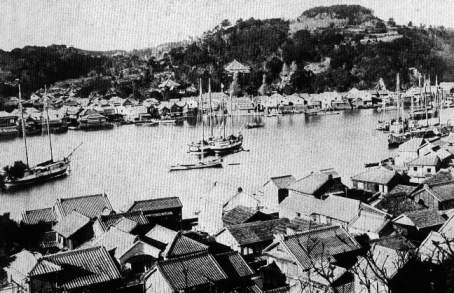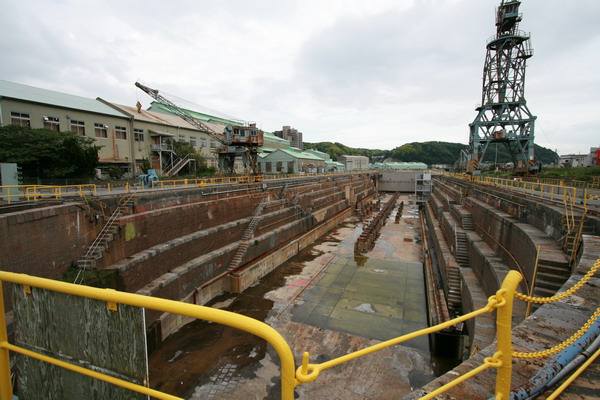When IJN fought Japanese-Sino War and Japanese-Russo War, IJN battleships were built by UK etc. IJN ordered UK building destroyer Urakaze which burned oil only and loaded 170t oil. It was launched on 14 September 1915, and was the last foreign made destroyer.
Yokosuka and Uraga
Yokosuka is near Uraga where once there was an office of Edo Bakufu. Therefore sometimes US ships anchored in Uraga to negotiate government of Japan in 19th century. William Adams[13] (Miura Anjin), an English diplomatic advisor of Tokugawa Ieyasu recommended British ships to anchor here.
Samurai or pirates of Kyushu had seen Western stle ships since 16th century, they were not interested to build Western style ships. They had been satisfied with modified Chinese style. A few lords of Tokugawa Ieyasu and Date Masamune[12], however, built western ships to voyage across the Pacific to Mexico. Ieyasu ordered William Adams to build a western ship at Uraga.
 |
 |  |
| French style dock | German style dock |
USN remained the Yokosuka Arsenal to maintain warships in Japan as well as UK did Seletar in Singapore to keep her China station, otherwise weapon department of Kure Arsenal was destroyed by 162 B-29s on 22 June 1945. IJN could use facilities of Seletar for a few years in the Pacific War.
-
My father was on a IJN destroyer, the destroyer was damaged by USAAF bombardment in Phillipines in 1945. She repaired the broken hole in Seletar, came back to Yokusuka.
 |
Pearl Harbor
USN began building Pearl Harbor Naval Shipyard in 1908[3]. After Japan Russo war, UK admitted to tie an equal treaty with Japan. US was the last nation that Japan and other nations tied an equal treaty. Japan knew power is the most important for international relation. Japan saw US imaginary enemy. Also US saw Japan an enemy in the Pacific. Both nations began to spend much money in their navies. They learned much from RN both. Art or military technology is a peak delaying after a peak of its civilization.
Bottle neck of Japanese shipbuilding
| Year | Japan | US | UK | Germany |
| 1900 | 0 | 36 | 17 | 23 |
| 1910 | 0 | 44 | 11 | 23 |
| 1920 | 1 | 59 | 13 | 12 |
| 1930 | 2 | 44 | 8 | 12 |
| 1940 | 3 | 43 | 9 | 13 |
USAF and USN did not destroyed most of them by air bombardment. GHQ allowed Japan to build a tanker of 10,000t in 1949. Allied nations allowed Germany to build ships in 1951. So introducing US shipbuilding technology especially welding, Japan prodctioned merchant ships as No.1 in the world in 1957. Japan built all welded submarine Oyashio using high tensile steel 50kg/cm2 (NS30) in 1959. 60kg/cm2 (NS46), 70kg/cm2 (NS63) and 85kg/cm2 (NS80) were capable for submarines in 1960, 1967, 1975.
I think Japanese welding productivity was worse than US. GE began welding to asseble disel engine for locomotive department, USN guided welding for commerce shipbuilding in 1935. While IJN prohibited welding for main stressed parts because of 4th Fleet Incident on 26 September 1935[2][6]. MILLER ELECTRIC MFG. CO. began selling alternative current welding machine in 1936. US and Germany built merchant ships of 18,000 WT and 6,000 WT by welding in 1936. A German engineer H.SCHMIDT came to Japan by U-boat to guide production of high tensile steel St52 capable for welding of submarine in 1943. US built merchant ships of 11.57 MGT at peak in 1943. While Japanese peak was 1944 and only 1.73 MGT.
[1] Ohuchi, p96
[2] Yousetsu no rekishi
[3] Pearl Harbor Naval Shipyard
[4] Yokosuka saidaino dock No.6
[5] Bei kantai no pilot
[6] Dai 4 Kantai Jiken
[7] 6.22 Kure Kaigun Koushou
[8] German style dock
[9] IJN Shinano (1944)
[10] DRY DOCK #1
[11] Uraga
[12] Date Masamune (1567-1636)
[13] William Adams (1564-1620)

aboutMe
© 2007-2010 Enoki Sensor All Rights Reserved